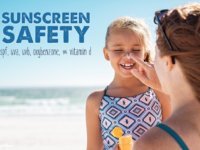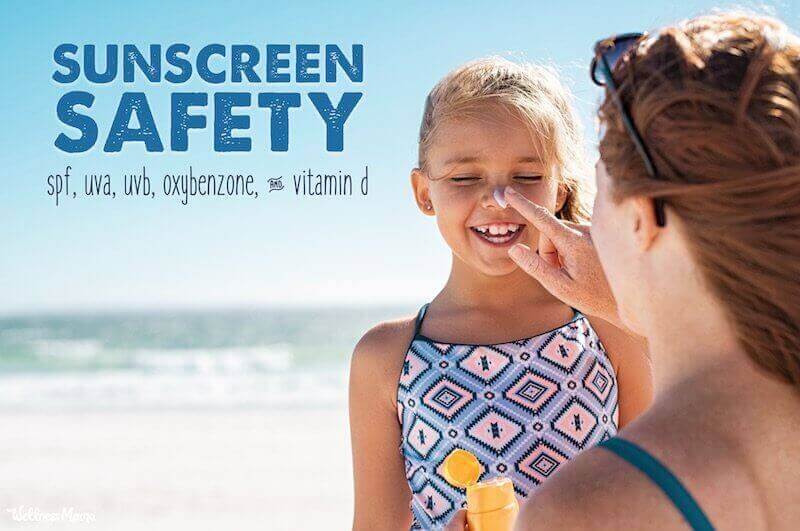

Years ago, I shared my homemade sunscreen recipe and explained why I avoid most conventional sunscreens. Recently, reports from the Environmental Working Group (EWG) and Consumer Reports have warned consumers against using many types of conventional sunscreens, especially on children.
Sunscreen is Harmful?
Sunscreen use has risen in past decades, as media outlets and doctors tout the benefits of sunscreen for protecting against skin cancer and sunburn. The problem with this billion dollar a year market: not all sunscreens are created equal and in many cases sunscreen is harmful, not helpful.
Here’s why:
There are two ways that a sunscreen can protect the skin from sun damage: with a mineral barrier or a chemical one.
Mineral sunscreens typically include ingredients like zinc oxide or titanium dioxide, which create a physical barrier to protect the skin from the sun.
Chemical Sunscreens…
Chemical sunscreens use one or more chemicals including oxybenzone, avobenzone, octisalate, octocrylene, homosalate and octinoxate.
If you’ve been around my blog before, you’ve probably seen my stance that if you can’t eat it, you shouldn’t put it on your skin, but these sunscreen chemicals raise some special concerns because many are able to cross into skin and other tissue.
With these chemicals, it is important to ask questions such as:
Will this cross the skin and get into other tissue in the body?
Does this chemical have the potential to disrupt hormones, especially in children?
Are there long-term or allergy reactions to these chemicals.
This new research by the EWG reveals that the chemicals commonly used in sunscreen are endocrine disruptors, estrogenic and may interfere with thyroid and other hormone processes in the body.
The most common sunscreen chemical, Oxybenzone, was found in 96% of the population by a recent study by the Center for Disease Control and Prevention. This is especially alarming since oxybenzone is considered an endocrine disruptor, can reduce sperm count in men and may contribute to endometriosis in women.
The EWG warns against using oxybenzone, especially on children or pregnant/breastfeeding women.
Even more alarming?
Of the 1,400+ sunscreens tested by the EWG, only 5% met their safety standards and over 40% were listed as potentially contributing to skin cancer.
I explain the reason that sunscreen may actually lead to skin cancer in this post, but one of the reasons is that a Vitamin A derivative, retinyl palmitate, that is often used in sunscreens was shown to speed up the growth of cancerous cells by 21%.
Spray sunscreens have become increasingly popular in recent years, but have additional dangers, especially if inhaled. Consumer Reports warns that spray sunscreens should not be used on children and that adults should exercise caution and make sure not to use on the face or inhale them.
Many sunscreens also contain methylisothiazolinone, which the American Contact Dermatitis Society named as its “allergen of the year”
The EWG’s most recent report listed Neutrogena as the #1 sunscreen brand to avoid, citing high concentrations of oxybenzone and other hormone disrupting chemicals, and misleading claims about their SPF levels.
Vitamin D Dilemma
Every time I talk about this issue, I get a lot of comments about how serious skin cancer can be (I agree) and why why it is reckless for me to suggest that people reconsider (conventional) sunscreen use (I disagree).
We’ve already established that some sunscreen is harmful and may do more harm than good, but another important consideration that is often ignored: Vitamin D.
Most sunscreens completely block the body’s ability to manufacture Vitamin D. Statistically, 75% of us are deficient in Vitamin D and Vitamin D deficiency has been linked to higher risk of cancer and heart disease (which kill more people than skin cancer per year). (1,2)
We might literally be cutting off our noses to spite our faces when it comes to sun exposure. We lather up with chemical sunscreens that have the potential to greatly increase skin cancer risk and reduce Vitamin D production in the name of avoiding skin cancer, and increase our risk of more widespread diseases related to Vitamin D deficiency.
Important Note:
The topic of if sunscreen is harmful is a loaded one. To be clear, I am NOT saying that we shouldn’t exercise caution in exposure (especially overexposure) to the sun, however, as more and more evidence emerges about the dangers of many sunscreens and their potential to increase rates of skin cancer, it is important not to depend on sunscreens or think that regular sunscreen use decreases the risk of skin cancer.
In fact, a study in the Journal of Clinical Pharmacology and Therapeutics reports that:
Sunscreens protect against sunburn, but there is no evidence that they protect against basal cell carcinoma or melanoma. Problems lie in the behavior of individuals who use sunscreens to stay out longer in the sun than they otherwise would. Vitamin D inhibition is, at this stage, unlikely due to insufficient use by individuals. Safety of sunscreens is a concern, and sunscreen companies have emotionally and inaccurately promoted the use of sunscreens.
Despite the push for more awareness about sun exposure, and the advice to use sunscreen whenever we go outside, incidence of skin cancer, especially melanoma, is rising dramatically.
A Safer Option: Mineral Sunscreens
Mineral sunscreens are typically considered a safer option, but with a few caveats…
Some mineral sunscreens also contain some of the chemical ingredients above and have the same risks.
Additionally, if nano particles of zinc oxide or titanium oxide are used, these can enter the body and carry risks as well. Since these offer physical barriers, it is also more difficult to accurately pinpoint the SPF of some mineral sunscreens.
My homemade sunscreen recipe and sunscreen lotion bars both use non-nano zinc oxide for a safe and natural sun protection. There are also some natural mineral sunscreens that the EWG lists as safe (and I’ve tried many of these personally):
- Alba Botanical Mineral Sunscreen
- Badger Mineral Sunscreen
- Babyganics Sunscreen or spray sunscreen
- All Terrain KidSport SPF30 Oxybenzone-Free Natural Sunscreen
- Blue Lizard Australian Sunscreen
- Bull Frog Sunscreen
- Burt’s Bees Sunscreen Stick
- California Baby Hypoallergenic Sunscreen
- JASON Mineral Sunscreen
- Naked Turtle Mineral Sunscreen with Aloe
- Sunology Natural Sunscreen
- Raw Elements Sunscreen
- The Honest Company Sunscreen
- Thinkbaby Safe Sunscreen
The Safest Option: Cover Up
If sun exposure is a big concern for you or you have a family history of skin cancers, the safest option is to avoid the sunscreens that the EWG has said might contribute to skin cancer and use the safest form of sun protection: covering up.
With all the information and mis-information about sunscreen out there, the easiest and safest way to avoid sun damage is to stay in the shade, wear a hat or long sleeves.
The recent research shows that certain chemical sunscreens may carry more of a risk than moderate sun exposure, so avoid these sunscreens is also an important step.
Internal Sun Protection:
Another important step to protecting the skin from sun damage is supporting the body internally.
This post explains internal sun protection in detail, but in short, it is important to avoid foods that increase inflammation, such as:
And to focus on foods and healthy fats that support skin health, including:
- Vitamin D3 (I take about 5,000 IU/day)- Emerging evidence shows that optimizing blood levels of Vitamin D can have a protective effect against sunburn and skin cancer
- Vitamin C (I take about 2,000 mg/day)- A potent anti0inflammatory, and it is good for the immune system too.
- 1/4 cup coconut oil melted in a cup of herbal tea per day- the Medium Chain Fatty Acids and saturated fat are easily utilized by the body for new skin formation and are protective against burning
- Fermented Cod Liver Oil/High Vitamin Butter Oil Blend (also great for remineralizing teeth)-Probably the most important supplement for sun protection. I take double doses during the summer and the kids take it too. Since adding this and the coconut oil daily, none of us have burned. It’s also great for digestive and oral health. (Amazon finally has the capsules back in stock)
- Astaxanthin– A highly potent antioxidant which research shows acts as an internal sunscreen. It’s also supposedly an anti-aging supplement. I don’t give this one to the kids though.
Bottom Line:
It is important to be responsible with sun exposure, but many sunscreens offer a false security of sun protection and may do more harm than good.
The safest option is covering up and supporting skin health internally and externally. Mineral sunscreens (without nano particles or sunscreen chemicals) are also a good option, but for the most part, spray and chemical sunscreens should be avoided.
With the widespread availability of natural mineral sunscreens on the market now, please consider choosing safer sunscreens for your family.
What sunscreen do you use? What is your biggest concern with sun exposure?
Why (Most) Sunscreen is Harmful originally appeared on Wellness Mama.
from Wellness Mama » Blog http://wellnessmama.com/55366/why-most-sunscreen-is-harmful/?utm_source=rss&utm_medium=rss&utm_campaign=why-most-sunscreen-is-harmful
via SEO Derby
from www.holisticclients.co.uk http://holisticclients.blogspot.com/2015/06/why-most-sunscreen-is-harmful.html
via For Free Social Media Coaching Click Here
No comments:
Post a Comment